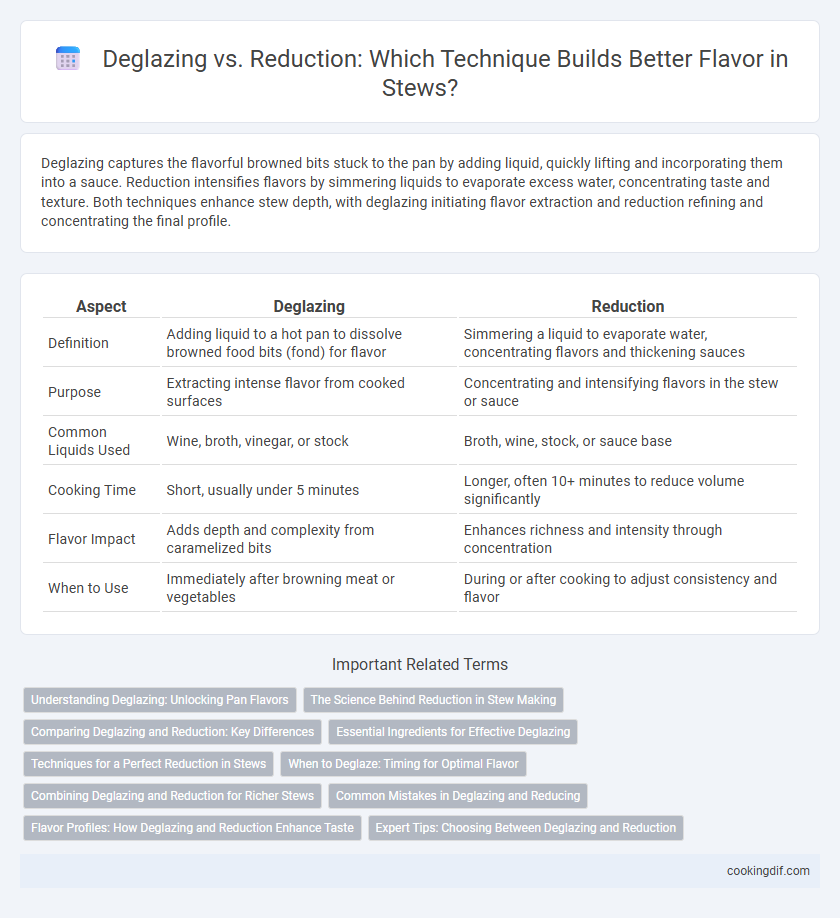Deglazing captures the flavorful browned bits stuck to the pan by adding liquid, quickly lifting and incorporating them into a sauce. Reduction intensifies flavors by simmering liquids to evaporate excess water, concentrating taste and texture. Both techniques enhance stew depth, with deglazing initiating flavor extraction and reduction refining and concentrating the final profile.
Table of Comparison
| Aspect | Deglazing | Reduction |
|---|---|---|
| Definition | Adding liquid to a hot pan to dissolve browned food bits (fond) for flavor | Simmering a liquid to evaporate water, concentrating flavors and thickening sauces |
| Purpose | Extracting intense flavor from cooked surfaces | Concentrating and intensifying flavors in the stew or sauce |
| Common Liquids Used | Wine, broth, vinegar, or stock | Broth, wine, stock, or sauce base |
| Cooking Time | Short, usually under 5 minutes | Longer, often 10+ minutes to reduce volume significantly |
| Flavor Impact | Adds depth and complexity from caramelized bits | Enhances richness and intensity through concentration |
| When to Use | Immediately after browning meat or vegetables | During or after cooking to adjust consistency and flavor |
Understanding Deglazing: Unlocking Pan Flavors
Deglazing involves adding liquid to a hot pan to dissolve browned bits, known as fond, which enhances the stew's depth and complexity by incorporating caramelized flavors into the sauce. This technique captures concentrated taste compounds that are otherwise stuck to the pan, creating a richly layered base for simmering. Compared to reduction, deglazing emphasizes flavor extraction from the cooking surface, making it essential for building robust, savory profiles in stews.
The Science Behind Reduction in Stew Making
Reduction in stew making intensifies flavor by evaporating water, concentrating the natural sugars, amino acids, and aromatic compounds within the liquid. This process promotes the Maillard reaction and caramelization, enhancing the stew's depth and complexity. Deglazing complements reduction by dissolving browned fond from the pan, introducing rich, savory notes that elevate the overall taste profile.
Comparing Deglazing and Reduction: Key Differences
Deglazing involves adding liquid, such as wine or broth, to a hot pan to dissolve browned food particles, creating a rich base for stews, while reduction concentrates flavors by simmering liquids to evaporate water. Deglazing quickly captures caramelized bits, enhancing depth and complexity, whereas reduction intensifies umami and sweetness by thickening the sauce. Both techniques are essential in stew preparation, with deglazing providing immediate flavor lift and reduction developing a more robust, concentrated taste.
Essential Ingredients for Effective Deglazing
Essential ingredients for effective deglazing in stew preparation include a flavorful liquid such as wine, broth, or vinegar to dissolve caramelized bits, concentrating rich flavors. Incorporating aromatics like garlic, onions, or fresh herbs enhances the depth and complexity during the deglazing process. Precise heat control ensures gradual flavor extraction without burning, balancing the stew's overall taste profile.
Techniques for a Perfect Reduction in Stews
Deglazing involves adding liquid to a hot pan to dissolve browned bits, enhancing stew flavor by incorporating caramelized residues. Reduction concentrates flavors by simmering liquids to intensify taste and thicken consistency, crucial for rich, robust stews. Achieve a perfect reduction by maintaining a steady simmer, stirring occasionally to prevent scorching, and monitoring the liquid level to avoid over-thickening.
When to Deglaze: Timing for Optimal Flavor
Deglazing should be done immediately after browning meat or vegetables in a stew to capture and dissolve the fond, the caramelized bits that contain intense flavor compounds. This process releases savory umami elements and creates a rich base that enhances the overall depth of the stew's taste. Timing the deglaze step before adding liquid ingredients preserves maximum flavor concentration for a more complex and robust stew.
Combining Deglazing and Reduction for Richer Stews
Combining deglazing and reduction techniques intensifies stew flavors by first lifting browned fond from the pan with a flavorful liquid such as wine, stock, or vinegar. This process incorporates deep, caramelized notes that form the stew's flavor foundation before simmering to reduce the liquid, concentrating taste and thickening the sauce. Utilizing both methods enhances the stew's complexity and richness, creating a more robust and savory dish.
Common Mistakes in Deglazing and Reducing
Common mistakes in deglazing include adding liquid to a hot pan too quickly, causing uneven flavor extraction and a diluted sauce. During reduction, overcooking can lead to excessive evaporation, resulting in a bitter taste and loss of the stew's natural richness. Proper temperature control and gradual liquid addition are essential to maximize flavor concentration and avoid these pitfalls.
Flavor Profiles: How Deglazing and Reduction Enhance Taste
Deglazing involves dissolving browned food residue with liquid like wine or stock, introducing complex, savory notes known as fond that deepen a stew's umami flavor profile. Reduction concentrates the stew's flavors by simmering the liquid, intensifying sweetness, acidity, and spice elements to create a rich, balanced taste. Combining deglazing and reduction techniques layers flavors, enhancing depth and complexity in slow-cooked dishes.
Expert Tips: Choosing Between Deglazing and Reduction
Deglazing enhances stew flavor by dissolving browned fond with liquid, capturing intense savory notes from the pan surface. Reduction concentrates stew components by simmering, intensifying depth and thickness through evaporation of water content. Expert chefs recommend deglazing early to incorporate robust caramelized flavors, then applying reduction to achieve desired richness and texture.
Deglazing vs reduction for flavor building Infographic

 cookingdif.com
cookingdif.com